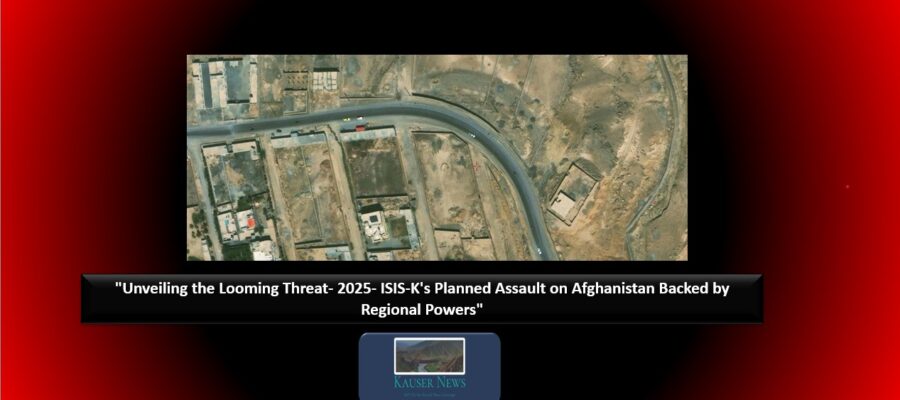The rise of ISIS-K (Islamic State Khorasan Province) in Afghanistan presents a complex threat matrix, not only for the nation but also for the broader region. With deepening connections to foreign intelligence agencies such as the KGB, ISI, and Iran’s intelligence services, Kauser News Agency has uncovered startling revelations. This article explores the unfolding scenario, dissecting the implications of ISIS-K’s potential attacks from the north and east of Afghanistan, and how these developments destabilize the country in the coming months.
ISIS-K is a branch of the broader Islamic State (ISIS) organization, established in 2015. Khorasan is a historic term that refers to a region that includes parts of modern-day Afghanistan, Pakistan, Iran, and Central Asia. Since its beginning, ISIS-K has engaged in some of the most brutal attacks in the region, targeting civilians, Afghan security forces, and international interests. After the fall of Kabul in August 2021 and the Taliban’s resurgence, the group has emerged as a rival to the Taliban, vying for control of Afghanistan and the greater region.
ISIS-K has remained resilient, partly due to external support and intricate connections with other militant groups and state actors. Recently, intelligence reports suggest the group may have received logistical and strategic support from a combination of regional powers, including Russia’s KGB (now FSB), Pakistan’s ISI, and elements within Iran’s intelligence services.
Kauser News Agency’s investigative report suggests that ISIS-K is preparing coordinated attacks from the north and east of Afghanistan. The northern provinces, particularly those bordering Tajikistan and Uzbekistan, have long been regions of instability due to their remote geography and historical presence of insurgent groups. Meanwhile, the eastern provinces bordering Pakistan have been hotspots for militant activities, with the region’s mountainous terrain offering shelter to insurgent fighters.
- Northern Afghanistan: Historically, northern Afghanistan has been a contested region, with the Taliban struggling to gain full control. This vacuum has allowed ISIS-K cells to proliferate. Reports suggest that ISIS-K may try to establish strongholds in these areas, capitalizing on the weakened local governance and exploiting ethnic and sectarian divisions, particularly between the Tajik, Uzbek, and Hazara communities.
- Eastern Afghanistan: The eastern regions of Afghanistan, particularly Nangarhar and Kunar provinces, have long been hubs for ISIS-K activity. With access to Pakistan’s porous border, ISIS-K militants have enjoyed safe passage and logistical support, enabling them to conduct cross-border operations with relative impunity. Recent discoveries by Kauser News Agency indicate that these attacks are likely to intensify, with plans to destabilize Kabul and other major cities.
The involvement of foreign intelligence services in supporting ISIS-K underscores the geopolitical complexity of the Afghan conflict. Each of these countries has its own motivations and strategic interests in the region, which align in some instances with the rise of ISIS-K.
While Russia has publicly condemned ISIS and offered military assistance to counter terrorism in the region, allegations have surfaced that factions within Russia’s intelligence apparatus are covertly supporting ISIS-K in a bid to destabilize Afghanistan and weaken U.S. and NATO interests. Russia’s historical involvement in Afghanistan dates back to its occupation in the 1980s, and its modern-day interest lies in controlling the instability that threatens its southern borders in Central Asia.
The KGB (now the FSB) is believed to have strategic alliances with ISIS-K, providing intelligence and logistical support. Russia has also been keen on using ISIS-K to weaken the Taliban, whom they view as unreliable and potentially hostile to Russian interests in the region. By fostering ISIS-K’s growth, Russia could create a protracted conflict that hampers any cohesive Afghan government from forming.
The role of Pakistan’s Inter-Services Intelligence (ISI) in Afghanistan has been the subject of international scrutiny for decades. Pakistan has a vested interest in influencing Afghan politics to secure its western border and prevent any strong alliance between Afghanistan and India. While Pakistan has historically supported the Taliban, reports suggest that the ISI may also be providing limited backing to ISIS-K as a counterbalance to the Taliban’s growing influence.
Kauser News Agency’s findings suggest that elements within ISI are covertly aiding ISIS-K by allowing the movement of fighters across the Durand Line and providing financial and logistical support. The ISI’s involvement might be driven by Pakistan’s interest in maintaining leverage over both ISIS-K and the Taliban, thus ensuring that Afghanistan remains fractured and dependent on Pakistani mediation.
Iran, a Shia-majority nation, has traditionally been at odds with Sunni extremist groups like ISIS. However, geopolitical realities sometimes lead to unlikely alliances. Iran’s involvement with ISIS-K is particularly perplexing, given the group’s ideological opposition to Shia Islam and its history of targeting Shia communities. Nonetheless, Kauser News Agency’s revelations suggest that Iran’s intelligence services may be supporting ISIS-K for tactical reasons.
Iran’s primary goal in Afghanistan is to undermine U.S. influence and maintain a buffer zone against potential instability spilling into its own borders. Iran’s rivalry with the Taliban, especially over water rights and control of border regions, may have pushed Tehran into covertly supporting ISIS-K as a tool to weaken the Taliban and ensure that Afghanistan remains unstable.
- Destabilization of Central Asia: With ISIS-K preparing attacks from the north of Afghanistan, neighboring countries such as Tajikistan, Uzbekistan, and Turkmenistan are likely to face spillover effects. These nations have long struggled with their own militant movements, and the resurgence of ISIS-K could inspire jihadist groups across Central Asia to launch attacks or seek alliances with ISIS-K.
- Humanitarian Crisis: Afghanistan is already reeling from decades of war, economic collapse, and the Taliban’s harsh rule. An increase in ISIS-K attacks would exacerbate the humanitarian crisis, leading to more civilian casualties, displacements, and a further weakening of the central government’s ability to govern effectively. This could lead to a new wave of refugees fleeing to neighboring countries, overwhelming the region’s already strained resources.
- International Terrorism: ISIS-K has consistently targeted foreign nationals and embassies in Afghanistan. As the group grows in strength, there is a strong likelihood that they will increase attacks on international targets, both within Afghanistan and abroad. This poses a direct threat to global security, as ISIS-K has shown a willingness to conduct high-profile attacks similar to those of ISIS in Iraq and Syria.
The Taliban, now the de facto rulers of Afghanistan, face a formidable challenge in countering ISIS-K. Since their takeover in 2021, the Taliban has struggled to establish control over the entirety of Afghanistan, particularly in the north and east where ISIS-K is strongest. While the Taliban have publicly declared their intent to eliminate ISIS-K, their efforts have been hampered by internal divisions, limited resources, and the complex terrain.
The Taliban’s primary strength lies in its ability to command loyalty from tribal leaders and local militias, but this is being tested by ISIS-K’s growing influence. If ISIS-K continues to expand, it could erode the Taliban’s authority, leading to a civil war between rival factions. This would further destabilize Afghanistan, opening the door to foreign intervention and a return to the chaos of the 1990s.
The international community, particularly the United States and its NATO allies, faces a difficult decision on how to address the rise of ISIS-K in Afghanistan. The withdrawal of U.S. forces from Afghanistan in 2021 was meant to signal an end to America’s longest war, but the resurgence of ISIS-K could draw the U.S. back into the conflict. Drone strikes and special operations missions targeting ISIS-K leadership are likely to intensify, but these efforts may not be enough to prevent the group’s expansion.
Russia, China, and regional powers like India also have a vested interest in preventing Afghanistan from becoming a haven for international terrorism. These countries may seek to coordinate efforts to combat ISIS-K, but their divergent interests and relationships with the Taliban complicate the possibility of a unified approach.
Afghanistan stands on the precipice of a new chapter in its turbulent history, with ISIS-K poised to become a dominant force in the coming months. The discovery by Kauser News Agency of foreign intelligence support for ISIS-K from the KGB, ISI, and Iran’s intelligence services highlights the geopolitical complexities that continue to shape the conflict.
ISIS-K prepares to launch attacks from the north and east, Afghanistan could be plunged into another cycle of violence and instability, with dire consequences for the region and the world. The Taliban’s ability to counter this threat will be tested, and the international community must brace for the potential resurgence of global terrorism emanating from Afghanistan. The next few months will be critical in determining whether Afghanistan can stave off this emerging threat or whether it will once again fall victim to external manipulation and internal chaos.





